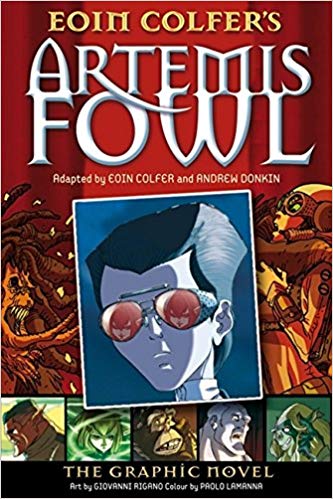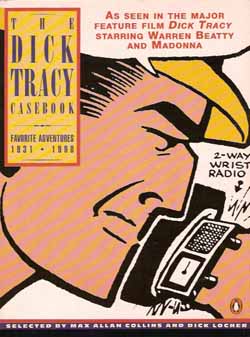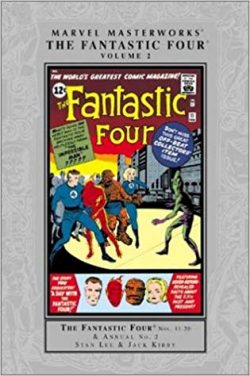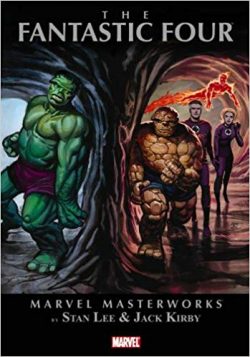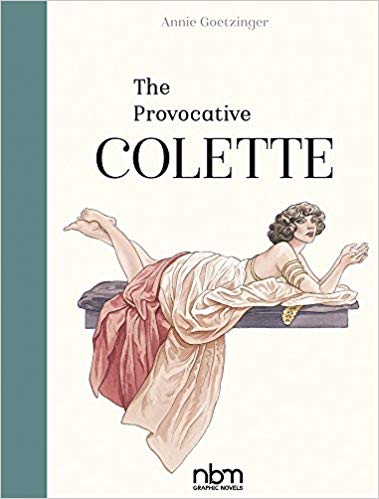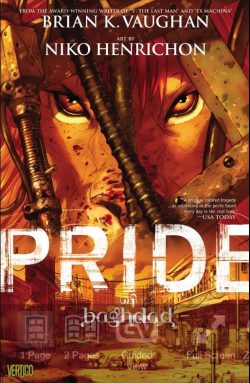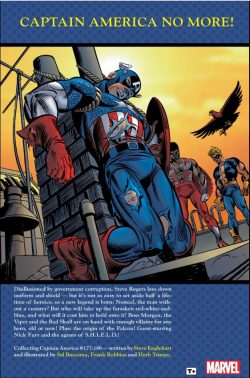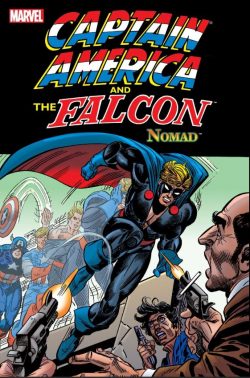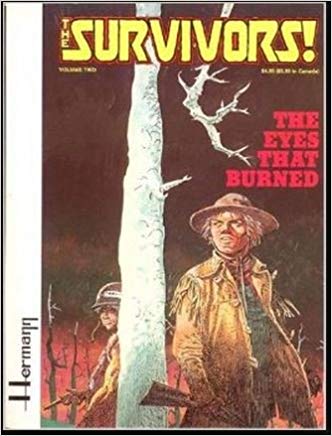
By Hermann, translated by Dwight R. Decker (Fantagraphics Books)
No ISBN: ASIN: B005KE6S2K
Hermann Huppen was born in 1938 in Bévercé, in what is now the Malmedy region of Liège Province, Belgium. He studied to become a furniture maker and worked as an interiors architect before finally settling on a career in comics.
His true vocation commenced in 1963 when he joined with writer Greg (Michel Régnier) to create cop series Bernard Prince for Tintin. The artist then added to his weekly chores with Roman adventure serial Jugurtha (scripted by Jean-Luc Vernal) and in 1969 expanded his portfolio further by adding the Greg-penned western Comanche to his seamlessly stunning output…
Bernard Prince and Comanche made Hermann a superstar of the industry – a status he has built upon with further classics such as The Towers of Bois-Maury, oneiric fantasy Bonnes Nuits, Nic!, Sarajevo-Tango, Station 16, Afrika and many more.
However, Hermann bravely dropped guaranteed money-spinner Prince (but stayed with Comanche because of his abiding love for western- themed material) when a rival publisher offered him the opportunity to write and draw his own strip. That was legendary European comics impresario (and Hermann’s agent) Ervin Rustemagic, who slotted his new dystopian thriller into German magazine Zack. Soon the strip was appearing in translation all over the world.
By my count there are 34 volumes and one Special Edition (most of which can be read as stand-alone tales) in circulation globally and has been serialised in Journal de Spirou, Metal Hurlant, Stripoteka and Politikin Zabavnik amongst others.
Jeremiah is a saga of survival and friendship in a post-apocalyptic world – with all the trappings of later hits like Mad Max – but inexplicably, despite its American settings and the sheer quality of the stories and art, has never really caught on in the US.
Fantagraphics were the first to introduce the unlikely hero and his world – retitled The Survivors! – in the opening years of the specialised Comicbook Direct Sales marketplace.
That heady air of enterprise and openness to new and different kinds of illustrated experiences somehow didn’t spread to Jeremiah, however, and the series vanished after just two translated volumes.
Catalan took up the challenge next with a single album in 1990, after which Malibu released a triptych of 2-issue comicbook miniseries between January and September 1991.
At the end of 2002, Dark Horse Comics partnered with Europe’s Strip Art Features syndicate to bring the series to the public attention again; releasing later albums with no appreciable response or reward, despite tying in to the broadcasting of J. Michael Straczynski and Sam Egan’s woefully disappointing TV series based on the strip.
In 2012 the publishers had another shot: releasing the first nine European albums in three of their always-appealing Omnibus editions. These are harder to find than hen’s teeth (even after a civilisation ending nuclear exchange) so now I’m having another go.
I’m not publishing anything, just categorically stating that Jeremiah – in whatever printed iteration you can find it – is one of the finest bodies of sequential graphic storytelling and illustrative excellence ever put to paper, so if you love science fiction, gritty westerns, rugged adventure or simply bloody good comics, somehow track down Hermann’s masterpiece and give it a go.
In case you need a bit of plot and context, here’s what happens in the first tale as delivered by Fantagraphics. La Nuit des rapaces was released as a French-language Album in April 1979 and picked up by the US Indy publisher in 1982.
It describes how America died, not due to political intrigue or military error but as the result of a grotesque and appalling race war.
When the dust settled and the blood dried, the republic was reduced to pockets of survivors scavenging in ruins or grubbing out a life from leftover machines and centuries-old farming practises. It was a new age of settlers, pioneers and bandits. There was no law but brute force and every walled community lived in terror of strangers…
In that pitiless world, Jeremiah was an unhappy, rebellious teen who craved excitement and despised his little dirt-grubbing, formidably-stockaded village of Bend’s Hatch.
He got his wish the night he was late home. Locked out and stuck in the desert wastelands, the callow boy encountered youthful nomadic scavenger Kurdy Malloy and wound up beaten and unconscious. The assault saved his life…
Finally reaching home next morning, Jeremiah found the village razed and burning, with everything of value taken – including all able-bodied men. women and children…
Assuming Kurdy at least partly responsible, Jeremiah tracked the wanderer and saved him from being tortured by other outlaws in the desert wastes. A cack-handed rescue resulted in them establishing an uneasy truce whilst Kurdy taught the kid the necessities of life on the run.
Determined to find his people, Jeremiah and Kurdy followed their trail to the thriving outlaw town of Langton. The makeshift metropolis was divided in two: ordinary folk and an army of thugs led by a debauched madman Mr. W. E. Birmingham…
From a central citadel his thugs run roughshod over everybody else, but before long the newcomers stoked resentment and anger into full rebellion…
When the shooting stopped the settlers were in control and Jeremiah convinced Kurdy to invade the Red Nation in search of the missing slaves…
Due to the exigencies of Fantagraphics’ licensing deal, the second translated volume was actually fourth Euro-Album Les Yeux de fer rouge (first released in 1980), but the jump is barely noticeable.
In Du sable plein les dent and Les Héritiers sauvages the lads successfully infiltrate and escape from tyrannical insular Indian country, but without freeing any captives. Now they are wandering the vast, malformed wastelands in search of a prisoner who has escaped the Red Dictatorship…
The Eyes That Burned opens in those eerie expanses with the brutalised boys uneasily catching glimpses of something strange dogging them. As night falls they meet a pioneer family whose wagon has become bogged down, but, even after tense, untrusting introductions slowly resolve into uneasy alliance, the combined stragglers are unable to free the conveyance.
The situation changes when macabre showman Pinkus L. C. Khobb pops up out of nowhere and has his heavily-cloaked performer and companion Idiamh lift the vehicle free. The weird strangers are gone before the party can thank them, but doughty matron Faye has had some kind of seizure and now sits comatose and unresponsive…
Unable to help, Jeremiah and Kurdy press on, tracking their target to a grim hell-hole town dubbed Lerbin’s Gate. Although they ride horses, they are amazed to find Pinkus has got there ahead of them. As they unsuccessfully enquire about the Indian escapee, the showman and his act perform spectacularly. The crowds are suitably enthralled but some of the visitors are taken strangely ill immediately afterwards…
When the boys decide to return to the wastes and scout around the Indian borderland, Pinkus is watching…
The altered terrain is a terrifying hellscape of sand, dust and petrified flora and before long, the lads are pretty sure their increasingly close calls with death are no accidents…
Eventually, they cross the barrier back into Indian territory and encounter motorised war parties rounding up escaped slaves. After a brutal skirmish they also face an utterly unexpected outcome: survivors from Bend’s Hatch being helped by a traitor in the Indian military and covertly running an underground railroad for fleeing slaves…
The reunion and exultancy only last until Pinkus pops up again, revealing his cruel conniving connection to the slaver state before turning his deadly mutant monster on the fugitives…
Sadly for the vile vaudevillian, Jeremiah is fast, observant, deeply intuitive and just as ruthless…
Fast-paced, explosively engaging, with wry and positively spartan writing and fantastic twists on classic cinema tropes, The Eyes That Burned uses beautiful pictures to tell a compelling story that is one the best homages to the wild west ever crafted. Try it and see…
The Survivors! volume Two: The Eyes That Burned © 1982 Koralle, Hamburg.

